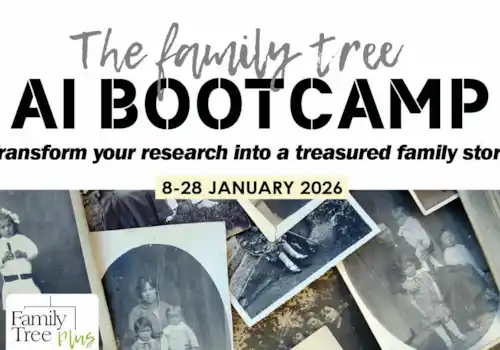Rachel Bellerby shares ten family-history-related websites where you can find surprisingly in-depth information relating to ancestors who fell foul of the law
Your first indication that an ancestor was convicted of a crime might be if you search for the person on the census and find him or her listed as a prisoner at one of the county’s jails. Or perhaps you’ve followed up on a half-forgotten family story and discovered an ancestor’s criminal past via newspaper reports. Either way, there are several ways in which you can find out more about an ancestor who was a victim, witness or perpetrator of a crime.
To start your search, you’ll need to work out which record office holds the records for your police force of interest, and then find out what records are available online. Generally, this will mean visiting the website for the record office and/or local history library for your place of interest, searching the catalogue and either exploring the material online, or enquiring about a research service. In addition, below are some specialised guides for various areas of the county.
For South Yorkshire, Sheffield has a PDF research guide that explains the history of policing in Sheffield, where information on police officers and criminals can be found, and the location of court records. Picture Sheffield has related images.
For North Yorkshire, Google Books has copies of volumes of quarter session records produced by the North Riding Record Society. These run into hundreds of pages and are searchable. Volume one can be found online. You can use this link to explore the subsequent volumes. Also visit archive.org for a digitised copy of Court of Quarter Sessions of the Peace (Yorkshire, North Riding) published in 1884.
North Yorkshire County Record Office also has a fascinating blog on the life and times of a selection of ‘criminal women’, including the tale of a five-week old baby sent in a parcel by train from Middlesbrough to Guisborough, from a quarter session case heard on 25 August 1869. The infant was sent inside a hamper by Martha and Mary Falkingham, according to the court session report, to a George Beaumont, who the women accused of having fathered the baby by Mary. The mother and daughter accused George of refusing to take responsibility for the child – an accusation he denied, saying that he had offered to marry Mary. Mary and her mother were sentenced to a month’s hard labour for ‘unlawfully and wilfully abandoning and exposing a child whereby the life of the said child was endangered’ and sadly, the child died at Guisborough Workhouse a few weeks after the court case, although apparently not from the effects of its journey.
Ancestry’s Register of Habitual Criminals and Police Gazettes 1834-1934 comprises registers and weekly newspapers with details of criminals, including habitual criminal registers, photographs and physical descriptions for the Victorian era and beyond. They also have West Yorkshire police records for 1833 to 1914, which includes registers of the appointment of regular and special constables, transfers, some physical descriptions and in some records, details of birth date and place, plus name of spouse.
Also at Ancestry are the Prisons and Calendars of Prisoners records 1801-1914, which covers Wakefield prison, and its prisoners, who came from across the West Riding. Originally known as the West Riding House of Correction and built in 1595, its buildings were replaced in the 1760s and in 1847. 27 years later, it became part of the national prisons system as H.M. Prison Wakefield. Your search will show prisoner’s name, sentence, nature of offence and previous offences. You may also be lucky enough to find other information on family members, residence, physical appearance and education.
If your West Yorkshire ancestor fell into crime at a young age they may have gone to one of the area’s reformatory schools: Calder Farm Reformatory, East Moor Community Home School or Shadwell Children’s Centre. The years covered in this collection are 1856, through to 1914, which is the privacy cut-off point.
Each of the above records was supplied with the assistance of West Yorkshire Archive Service.
At FindMyPast you can find England & Wales, Crime, Prisons & Punishment 1770-1935 a collection of five million records on criminals who passed through the justice system, including the sentence given and what life was like in prison. If you’re fortunate, you might come across a photograph of your ancestor and a sample of their handwriting. When carrying out your search, select ‘place’ as one of the search parameters and a drop-down menu will show the assize records for locations including Leeds, Beverley, Bradford and the North Riding.
Ancestry has Yorkshire Quarter Session records for the period 1637 to 1914 – covering criminal cases heard in Bradford, Halifax, Huddersfield and Wakefield. Many of the cases run across several pages, so be sure to use the arrow function to browse the surrounding pages. FindMyPast has quarter sessions for Sheffield for 1880-1912, comprising more than 11,000 records.
For North Yorkshire, the York Cause Papers Database searchable catalogue of more than 14,000 cause papers relates to cases heard between 1300 and 1858 in the Church Courts of the diocese of York. The original records are held in the Borthwick Institute for Archives at the University of York, and are the most extensive records of their type in the UK.
About the author - Rachel Bellerby
Rachel Bellerby is the author of the book ‘Tracing Your Yorkshire Ancestors on the Internet’, published by Pen & Sword Publishing on 31 July 2024. Find out more at Pen and Sword Books: Tracing your Yorkshire Ancestors on the Internet - Paperback (pen-and-sword.co.uk)







